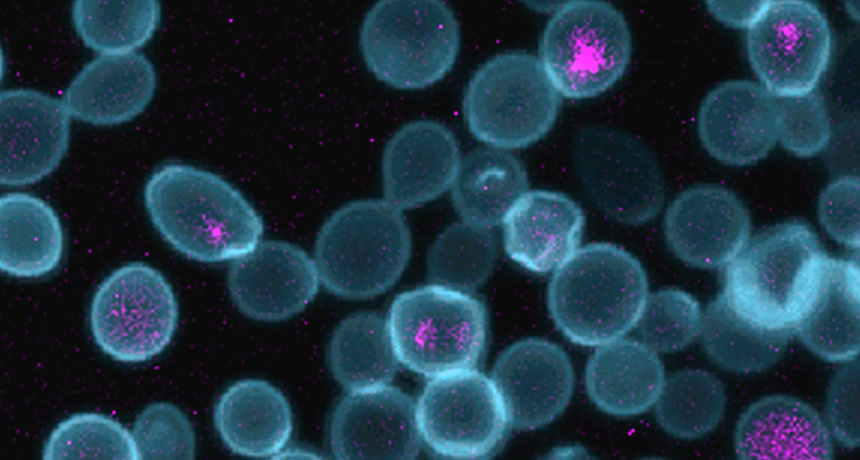
YOU COMPLETE ME Yeast cells (blue) harboring E. coli bacteria (purple) work together to provide each other energy and nutrients. The hybrid cells may help scientists learn more about the evolution of mitochondria, the organelles that make energy for cells.
Paul Webster
- More than 2 years ago
Yeast intentionally stuffed with bacteria may teach scientists something about the origins of cells’ powerhouses.
Cellular power-generating organelles, called mitochondria, are thought to have once been bacteria captured by archaea, single-celled microbes that are one of the earliest forms of life. Now, almost all eukaryotic cells (cells with a nucleus) contain mitochondria. At first, the bacteria may have lived inside archaea as endosymbionts, independent organisms that cooperate with their hosts. Over time, mitochondria lost many of their genes and eventually became an integral part of the cell.
This scenario has support from genetics. But “if you really want to prove something’s true,” says chemical biologist Peter Schultz, researchers should be able to make something similar in the lab. So Schultz, of the Scripps Research Institute in La Jolla, Calif., and his colleagues created a hybrid cell by fusing two popular lab organisms — the baker’s yeast Saccharomyces cerevisiae and a common gut bacteria called E. coli.
“It’s a pioneering approach,” says evolutionary biologist Antonio Lazcano of the National Autonomous University of Mexico in Mexico City, who was not involved in the experiments. No one has made such a hybrid organism before. But the work, described October 29 in the Proceedings of the National Academy of Sciences, suggests it may not be so hard to make a free-living organism into an endosymbiont, he says.
Not that it was easy to get bacteria adapted to living on their own to grow inside another species’ cells. First, the researchers had to give the yeast and bacteria a reason to team up.
Schultz’s team disabled a gene in yeast’s mitochondria so that the organelles couldn’t produce chemical energy in the form of adenosine triphosphate, or ATP, under some circumstances. E. coli were engineered to lack a gene needed to make the B vitamin thiamine, which the bacteria need to live. The team also outfitted the bacteria with a transporter protein that can move ATP and its precursor adenosine diphosphate, or ADP, in or out of the cell. When the bacteria was put inside the yeast cells, the bacteria supplied the ATP the yeast needed to live, and the yeast made thiamine for the bacteria.
It wasn’t a perfect arrangement, though. The yeast kept digesting the bacteria. So Schultz’s team equipped the E. coli with SNARE proteins from Chlamydia trachomatis bacteria, which can live inside human cells and cause the sexually transmitted disease chlamydia. SNARE proteins can prevent a host cell’s digestive compartments, called lysosomes, from coming together to dismantle invading microbes. SNARE-outfitted E. coli eventually were able to grow inside the yeast cell, the researchers found. The hybrid yeast-bacteria cells grew for more than 40 generations, the researchers report.
There’s no way to know the exact environmental and physiological conditions microbes faced that led to formation of eukaryotic cells 1.5 billion years ago, says evolutionary biologist Ryan Gawryluk of the University of Victoria in Canada who was not involved in the work. Exchanging energy for nutrients may have been one impetus for bacteria and archaea to join forces, but some scientists don’t think it was the evolutionary force that shaped the partnership, he says. After all, “bacteria have no interest in sending ATP outside of their cells.” Mitochondria-precursor bacteria may have been parasites or endosymbionts that gradually lost the ability to live outside the host for other reasons.
Still, Gawryluk says, the new study offers “an exciting result … showing how this potentially could have happened.”






